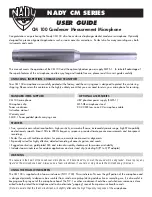
30
Cross Remote Precautions
This section provides information about various points to keep in mind when setting up and operating a Cross Remote
system.
In the Cross Remote service area, the two wireless signals for the main (UHF) link and remote control
(2.4 Ghz) link must be available together.
Equipment must be installed in such a way as to ensure that the main (UHF) link and remote control
(2.4 GHz) link wireless signals will not be interrupted in the Cross Remote service area.
When installing main link equipment including antenna, receiver, and remote control unit, the possibility of
interference from other equipment should be taken into consideration.
Design the installation so as to minimize the risk of interference from TV broadcast transmission, other wireless
systems, and common frequency channels within the same wireless microphone system. If interference is
occurring, increase the distance between the interference source and the wireless microphone system, turn
power to the interference source off, or take other suitable measures.
Regarding the remote control link, the interference risk from other equipment using the 2.4 GHz band
should be taken into consideration. Increase the distance of the wireless microphone system to possible
interference sources and select equipment to avoid the possibility of simultaneous operation of other 2.4
GHz equipment.
ST mode:
Uses 2.405 GHz (11ch), 2.425 GHz (15ch), 2.450 GHz (20ch), and 2.475 GHz (25ch). When there is
other equipment that uses the 2.4 GHz band, these channels should be avoided.
NT mode:
Uses 2.420 GHz (14ch), 2.445 GHz (19ch), and 2.470 GHz (24ch). When there is other equipment
that is using the 2.4 GHz band, these channels should be avoided.
2.4 GHz band radio wave propagation is highly linear and not easily deflected. When people or objects
are present in the path between the remote control unit and transmitter, reception field strength may
decrease drastically. Always try to ensure a direct line of sight between remote control unit and the wireless
microphone and transmitter.
To ensure stable transmission of 2.4 GHz band signals and prevent adverse influences from blocking by
obstacles, it is recommended to use a minimum of two RMU-01 remote control units. When multiple units are
used, the distance between installation locations should be about 10 to 20 meters. Up to nine remote control
units can be used within one system.
When multiple remote control units are used simultaneously, they should be spaced at least 10 meters apart.
The equipment should be kept as far as possible from wireless LAN access points or other equipment using
the 2.4 GHz band.
In NT mode, the whip antennas supplied with the Digital Wireless Receiver DWR-R01D cannot be used. (When
the receiver detects a remote control unit, it automatically switches to NT mode.) When there is an adjacent
system using NT mode, add a remote control unit to the current system and also operate it in NT mode.
Main (UHF) link precautions
Design the installation so as to minimize the risk of interference from TV, other wireless systems, and common
frequency channels within the same system.
Select channels so as to prevent interference
If interference is occurring, increase the distance between the interference source and the wireless
microphone system, turn power to the interference source off, or take other suitable measures.
Remote control (2.4 GHz) link precautions
Design the installation so as to minimize the risk of interference from other devices that use the 2.4 GHz band,
and be wary of close proximity between devices and simultaneous use of multiple devices.
WiFi and Bluetooth and other applications also use the 2.4 GHz band. Special care must be taken in
locations where large numbers of people congregate, such as at trade shows etc.
Also take care to avoid interference from wireless remote controls for lighting appliances.
Ensuring a Stable Service Area
Preventing Interference
Cross Remote Precautions
This se
suppo
System
Syste
D
System
Technology
Co
















































